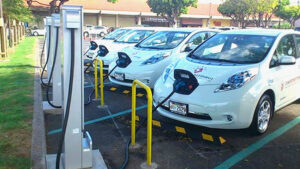The Future is Now for Electric Vehicles
Mark Druckmiller Car Museum Facebook Group
This is probably going to be a shock to some, but is already common knowledge in the industry. The auto industry (main companies AND suppliers) have moved away from ICE vehicles and are going mostly electric.
What you’re seeing now in the dealerships and roads are cars that were planned over five years ago.
Most hybrid vehicles and systems as well are going to be the closest to having any “near term “ ICE engine development and that’s only going to be for a short time.
My wife is an executive at a supplier and the suppliers have been putting in NO development money in ICEs over the last four years.
You have just seen over the last few years, even when Trump rolled back emissions and fuel economy standards here in the U.S., the automakers mostly have been ambivalent and in the case of GM, they supported the rollbacks. But that was mostly for show for their stockholders (less regulations lead to more short term profit). GM is no longer joining Trump’s lawsuit with California to eliminate their emissions standards.
So for anyone hoping for a new all-out V8 Mustang , the next generation (S650) will most likely split the focus on hybrid versions and the all electric Mach E.
The Charger/Challenger cars will be further electrified (hybrid and later full electric).
But really this isn’t a U.S. thing, obviously this is worldwide. But that’s what driving the push towards electrification.
The following article makes it sound like this was a recent decision.
It isn’t.
Carlos Tavares, CEO of French automaker Groupe PSA and future head of its merger with Fiat Chrysler Automobiles NV, says the parent of Peugeot, Citroën and Opel vehicles is no longer spending on internal combustion engine programs.
“That’s clear,” Tavares said on the subject during the Reuters Automotive Summit teleconference. “We are not investing more.”
“The point is … how much time you give the industry to adapt to this situation and how much time you give the industry to train people to different jobs or readjust their company to this different reality,” Tavares said. “The shorter the time we do have, the more brutal it will be, and the more social consequences it will have.”
In order for the alternative electric vehicles to be profitable, automakers need to cut back, because battery-electric technologies are more expensive than their traditional counterparts, Tavares said.
“Either we sell the cars at the right pricing to protect the margins, and we lose part of the middle class that cannot afford these kind of products, or we compensate for the incentives of the government when the governments don’t, and then we sell the cars in the red,” he said. “In both cases, either we lose a significant amount of our customers or we sell in red ink.
“The only way to step out of this process is by an accelerated pace of cost reduction, generating a very significant cost reduction for the cost of technology, that will protect the affordability while being zero-emission mobility. That’s a very difficult situation.”
The resulting impact of the costs for research-and-development and capital expenditures across a large volume basis is that some automakers will face regulatory penalties or financial challenges, Tavares said, leading to consolidation in the industry. PSA is far ahead in meeting European Union CO2 emission targets, he said, but it is combining with Fiat Chrysler to help with the strain on funding the new technology. The deal is expected to close in March.
“Only the most agile with a Darwinian spirit will survive,” Tavares said. “I think we will be able to adapt to that. We have demonstrated enough agility and Darwinian spirit to adapt to that.”
1400 HP Electric Mustang with 7 motors
Click to see Electric performance vehicles to come
